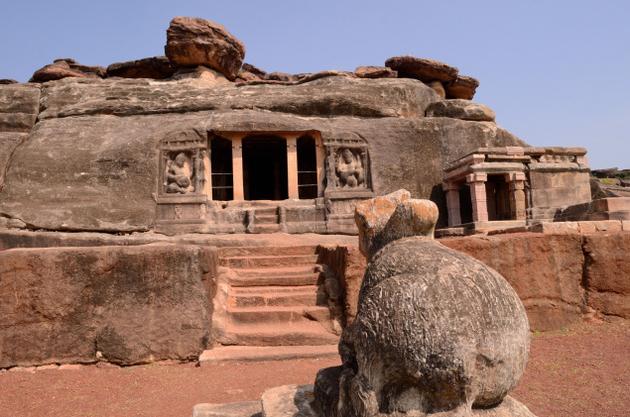What’s in the Name…?

June 28, 2013: Sitting on the steps of a cave temple in Aihole and staring right into the eyes of a Nandi that looks at me, I wonder what’s in a name. I had just visited the Durga Temple in Aihole that owes its name not to the goddess, but to a fort (Durg) built close by. And the adjacent Lad Khan temple, a Shivalaya, takes its name from a pious seer who apparently stayed there several centuries ago.
Walking around the ancient town of Aihole through narrowing alleys and gullies, a monument interrupts me every street corner. There are no houses or markets, just 125 temples scattered all over the ancient Chalukyan town. And one such cul-de-sac takes me to this cave temple. And a bright board gives it a name — Ravanaphadi.
A frangipani (the temple tree) tree blooms in the corner while a smattering of grass grows in the compound. Two brothers rush in to fetch their father who is the unofficial guide, while I ponder over the name, looking at a column that stands in the centre. Built in the early Chalukyan style of architecture in the 6th Century, this is one of the oldest cave temples here. The entrance has relief images of Nidhis with their pot bellies, but I am more fascinated by two guardians who seem to be dressed rather like foreign mercenaries, with spears.
A rock sits precariously atop the cave as the flight of steps takes me inside the temple, which has three shrines — each has a porch that leads to a chamber. We enter the main cave temple to see a rock-cut mandapa with chambers on three sides. Bright sunlight streams in and the cave turns into a veritable art gallery of Shiva, while Parvati, Ganesha and Karthikeya add to the pantheon of gods carved on the walls.
The most outstanding sculpture in the rock-cut cave is a panel which has a 10-armed Shiva performing the cosmic dance in the company of Parvati. Surrounding them is a tableau of deities — Saptamatrikas, Ganesha, Karthikeya, Varaha and Brahmi. There is a linga here as well, and as you look around, the sculptures take over your attention. The cave does not seem to have been completed.
There are other carvings besides the guardians of Shiva. You can see Ardhanarishwarar with a trident, a carving of Harihara with a snake and conch in his hands, Shiva with the river goddesses, among others. The rocks are carved with stories from mythology, as deities and demons take over. There is Varaha rescuing Bhumadevi, and Durga slaying the demon Mahisha. You look up to see more beautiful ceiling panels, but I am more fascinated by the central lotus medallion adorning the mandapa ceiling.
Each carving is larger than life, and makes the dark, dingy walls come alive. The silence is overwhelming. The watchman points out to every sculpture and tells a story, but he has no idea why it is called Ravanaphadi. All that he says is that it is also called Ravalaphadi.
I step out to see cotton-candy clouds forming over a bright blue sky. I sit on the steps and take in the scene for a while, until the heat gets to me. And then the next monument beckons.
Source: The Hindu, DT. June 28, 2013.







